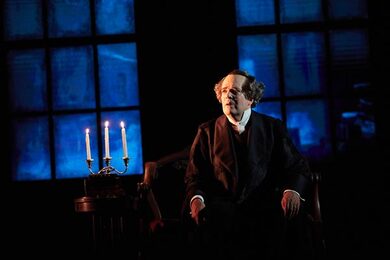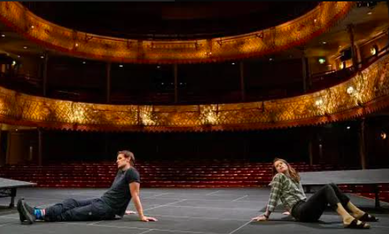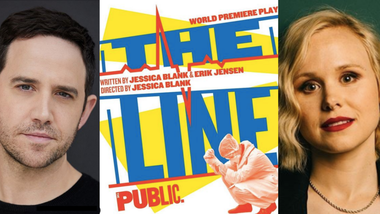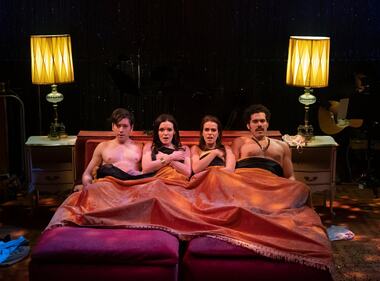For those of us who love the performing arts, 2020 has been a rough year. Since mid-March, nearly all live events have been halted, leaving millions who possess careers in the arts and cultural sector in limbo and those who thrive on attending these events in withdrawal.
Unfortunately, I only saw a limited number of live theatrical productions between January and March. The week following the shutdown, I had the first of many late winter and spring theater trips to New York City planned. In fact, I already had tickets in-hand for Lincoln Center’s Intimate Apparel and Flying Over Sunset, new plays by personal favorites Tracy Letts (The Minutes), Lucas Hnath (Dana H.) and Martyna Mayok (Sanctuary City), and star-studded revivals including Company and NYTW’s Three Sisters. I am keeping my fingers crossed for many of these productions to return in seasons to come.
Always resilient, individual artists and cultural organizations adapted during these times to provide audiences with live and filmed streamed content and, in some special cases, live, socially-distanced performances. While this year’s list is not nearly as robust as usual, I thought it was essential to continue this annual tradition and celebrate and honor those theater makers who persevered through this year and kept the art form alive through both virtual and in-person platforms. Here is the Best of 2020.
Unfortunately, I only saw a limited number of live theatrical productions between January and March. The week following the shutdown, I had the first of many late winter and spring theater trips to New York City planned. In fact, I already had tickets in-hand for Lincoln Center’s Intimate Apparel and Flying Over Sunset, new plays by personal favorites Tracy Letts (The Minutes), Lucas Hnath (Dana H.) and Martyna Mayok (Sanctuary City), and star-studded revivals including Company and NYTW’s Three Sisters. I am keeping my fingers crossed for many of these productions to return in seasons to come.
Always resilient, individual artists and cultural organizations adapted during these times to provide audiences with live and filmed streamed content and, in some special cases, live, socially-distanced performances. While this year’s list is not nearly as robust as usual, I thought it was essential to continue this annual tradition and celebrate and honor those theater makers who persevered through this year and kept the art form alive through both virtual and in-person platforms. Here is the Best of 2020.

1. Charles Dickens’ A Christmas Carol: Full disclosure: I generally don’t get too excited by stage adaptations of A Christmas Carol. Sacrilegious, particularly around this time of year; I know. As much as I adore Dickens’ tale, I often find what have become ‘traditional’ mountings to be snooze fests - uninspired and stale. Of course, I have my favorite film adaptations ranging from the sentimental, Scrooge (1970) to the unconventional Scrooged (1988). I’m only slightly embarrassed to admit that I was known to watch the Leslie Bricusse musical adaptation year-round as a child. And the hilarious and pitch perfect Richard Donner film starring Bill Murray has become somewhat of a seasonal tradition. So it comes as a bit of a surprise that this year’s filmed adaptation based on a 2018 Geffen Playhouse production should top my 2020 list. Although, I honestly should have had more faith given that this work is a collaboration between Michael Arden, one of the American theater’s most inventive stage directors and Jefferson Mays, one of the most talented actors to grace the contemporary stage. Paying homage to Dickens’ own tours and recitations of A Christmas Carol, Arden and his brilliant team of designers give us the most sublime and magical evening of Readers Theater imaginable. With adaptors Arden, Mays and Susan Lyons leaving most of Dickens’ text intact, Mays transitions from narrator to Ebenezer Scrooge to over 50 other characters throughout this one-man journey. And Mays is absolutely sensational. From his “once upon a time” with the fog rolling in from the streets of London, we are transported by the words of Dickens and Mays' bottomless bag of vocal and physical transformations. As he effortlessly slips from the misanthropic Scrooge to his benevolent nephew Fred, we know we are in for a treat. Whether distorting his face and limbs as the frightening Ghost of Marley or elevating himself from his toes through his joints, growing before our eyes, as the giant Ghost of Christmas Present, Mays makes his apparitions distinct. The color, variety, and layers that Mays brings to his narration is commendable and quite astonishing. Like Dickens, Mays is a lover of words. As Mays, the narrator, declares that Ebenezer “remembered everything” and “enjoyed everything”, it is astonishing how Mays, the Scrooge, is showing us just that. Even his simple, strategic tempo, particularly as he ascends the staircase of Scrooge’s cold, cavernous home, leads to an eerie suspense that is unmatched in any of the other film versions that have preceded it. Arden and Mays make Ebenezer’s transformation gradual and believable through generous beats connecting words, characters, and actions in each stave with Scrooge’s behavior earlier in the narrative. This is perhaps most explicit and effective in the scenario when Scrooge overhears his own words (“If he be like to die, he had better do it, and decrease the surplus population”) and he hangs his head and is overcome with “penance and grief.” With an actor as gifted as Mays, the one-man concept becomes an inherently brilliant one. Having the ghosts, characters past and present, joyous memories, and the feelings of sadness, regret, guilt, and melancholy all come from within the man, we believe in and applaud Ebenezer’s moral transformation more than ever. His need to change and his desire for redemption are propelled by these same powerful internal psychological forces. Years ago, popular actors and matinee idols, like James O’Neill and his Count of Monte Cristo, would recreate their most famous roles on tour for a lifetime. Mays is so good in this production, one almost wishes this theatrical tradition would continue with Mays reprising his role live for generations to come. Fortunately, he can with this first-rate filming. Here’s hoping a streaming service will purchase and distribute it for us to enjoy for future Christmas seasons. I think I’ve found a new favorite A Christmas Carol. Don’t tell Bill Murray.

2. Lungs: London’s Old Vic reunited Claire Foy and Matt Smith, perhaps best known for their portrayals of Queen Elizabeth II and Prince Phillip on Netflix’s Windsor drama The Crown, in Matthew Warchus’ electric production of Duncan MacMillan’s Lungs. The British theater is showcasing an embarrassment of riches by producing production after production from some of the most interesting contemporary playwrights. And along with Nina Raines (Tribes) and Lucy Prebble (The Effect), I would include Duncan MacMillan (Every Brilliant Thing and People, Places, and Things) as one of the playwrights whose new works I most look forward to seeing. Performed in an empty theater, staged with socially distanced precautions in place, and streamed live using multi-cameras, wide shots, and split screens, the Old Vic comes closest to replicating the theatrical rush one gets from watching in-person theater. Tickets were affordably priced, though each performance was limited to the Old Vic’s capacity; creating a feeling of exclusivity for a medium generally built for scale. Lungs follows an unnamed man (M) and woman (W) over the course of their relationship through a series of quick scenes highlighting moments of love, debate, frustrations, and heartbreak in the couple’s lives. The play, unfolding in a fast-paced 90 minutes, leaves the audience with the effect of seeing the couple’s lives flash before their eyes. MacMillan delivers characters that are both instantly recognizable and inarguably layered. His man and woman are liberal and thoughtful, yet, at times, egocentric and impulsive. They live with the instinct to do the right thing and yet are in regular need for the affirmation that they are, in fact, good people. In short, they are imperfect; they are us. Performed without set, props, costume or lighting changes, it is a marvel to watch Foy and Smith bracket each beat and shift from episode to episode. Where some of the episodes lack novelty (e.g. deciding whether to have children, facing infidelity in a relationship), MacMillan’s subtext-rich dialogue and dynamic structure bring an appreciated freshness to the piece. Foy and Smith bring such truth to each moment and deliver such complexity and authenticity to their characters that we are left longing for the day when we can be back in the same space with such talents.

3. Apple Family Zoom Plays: Early on during this pandemic, I devoured all four and all three Richard Nelson’s Apple and Gabriel Family plays set in Rhinebeck, NY. It was Nelson’s initial ambition to “put the most complex, complicated people I can on stage and let them talk about their country today.” I fell in love with Nelson’s characters so much that I envisioned booking an Airbnb and planning a weekend escape to Rhinebeck following the pandemic - a getaway filled with great friends, wine, dinners, music, and conversations. As each play in the series premiered, Nelson began to refine the purpose of his plays: “It is my hope that these plays are about the need to talk, the need to listen, the need for theater, and the need to be in the same room together.” And in his final installment (Regular Singing), he wrote “I hope that these plays are also about the need to know, in a small and even some bigger ways, that we are not alone.” Little did Nelson know that his series would fulfill all of these ambitions, and then some, when the Apple Family returned through a new medium: Zoom. Premiering on the dates they were set, the Apple Family plays were known for being incredibly specific in time and place (e.g. the 2010 election, the tenth anniversary of 9/11, Obama’s reelection, and the fiftieth anniversary of JFK's assassination). While the dates on which the Zoom installments premiered were less purposeful in timing, the Apple Family’s struggles with 2020’s ongoing pandemic were no less specific to the moment. Like welcoming old friends into your home virtually, we are grateful for the opportunity to hear from these characters and their challenges grocery shopping and working remotely, their moments of loneliness, their own COVID scares, and even the deaths of friends and acquaintances. Whether swapping stories Decameron-style during the early months of quarantining, sharing concerns about struggling industries and institutional racism, or describing tentative, but desired first steps back into the world, COVID-19 has only heightened the necessity of conversations like these for both the Apples and for us. While each of the three plays are of varying quality, the ridiculously talented real-life couple Maryann Pluckett and Jay O. Sanders consistently deliver solid, grounded performances as the eldest Apple siblings, Barbara and Richard. But perhaps the most moving moment of this Zoom trilogy belongs to Marian Apple (an exquisite Laila Robins) as she so eloquently describes the isolation and loneliness she has felt over these past months. We feel her heartbreak, and at that moment, feel the “need for theater and the need to be in the same room together.” Well done, Mr. Nelson.

4. The Line: Thank God for New York City’s Public Theatre during this pandemic. Not only did they commission the three Richard Nelson Apple Family Zoom plays on this list, but they also produced Jessica Blank and Erik Jensen’s powerful documentary drama, The Line. The Line showcases seven actors portraying real-life front-line heroes, specifically New York doctors, nurses, and paramedics during the first days of the pandemic. With a script derived directly from interviews, the text and performances are raw and blunt; as one might expect from shell shocked medical professionals who have stared death in the face. The personas vary from a seen-it-all, native New Yorker and long-time EMT who was inspired to go into the profession after 9/11 to a young doctor learning to sink or swim in her first-year residency to a geriatric nurse who returned to her beloved patients after kicking COVID herself. The stakes are heightened even more by the fact that the virus was as mysterious as it was deadly during these earliest days. While the subjects sharing their perspectives would be the last to tout their heroism, their stories of record-setting caseloads, makeshift protective gear and medical supplies, caring for family members, and the losses they’ve experienced beg to differ. These subjects also aren’t afraid to call out Washington’s failed response strategies and the racial inequities that have only been exacerbated by this pandemic. It is so easy to be numb to the sobering statistics on the nightly news. The Line reminds us that the true tragedy behind this pandemic is in the powerful individual human stories. Giving voice to these stories, through sensitive and moving portrayals, were Santino Fontana, Arjun Gupta, John Ortiz, Alison Pill, Nicholas Pinnock, Jamey Sheridan, Lorraine Toussaint.

5. Bob & Carol & Ted & Alice: Musical creators Duncan Sheik, Amanda Green, and Jonathan Marc Sherman display a great admiration toward Paul Mazurksy’s Bob & Carol & Ted & Alice, a late 60s popular film satirizing early middle age and bourgeois values amidst a hipper sexual revolution. While the material is still incredibly funny and Mazurksy and Tucker’s funniest bits are all preserved, these creators hold back on the satire developng a one-act musical that is quite sincere and feel-good. While the film’s satirical perspective remains intact in places, particularly in the musical’s early couples retreat scenes, Sheik and Green’s score grounded the material more by illuminating the characters’ insecurities, frustrations, and existential perplexities. This musical thankfully resists (for the most part) poking fun at the period, but instead shows an affection for the fashion, Burt Bacharach-style tunes, and the style. And three-fourths of this quartet give pretty terrific performances - Jennifer Damiano (Carol), Michael Zegen (Ted), and Ana Nogueira (Alice) all knock it out the park with their hysterical and compassionate portrayals. Aside from the title characters, the only other player onstage is singer-songwriter Suzanne Vega as “The Band Leader”. The role helps streamline the narrative and adds some welcome theatricality serving as a Brechtian device to deliver songs commenting on the action and to take on the portrayals of other characters in the story. In addition to the use of the Band Leader, director Scott Elliott utilizes audience participation to help play out scenes where more characters are needed (e.g. participants at the retreat, passenger on the plane). Although these bits achieved mixed success on the afternoon I caught the show, this concept paid off big time for the finale when the foursome graciously invited members of the audience to slow dance with them onstage. Elliott gives his couples a beautiful moment to connect with us and ultimately each other as he pays homage to the impact of Mazurksy’s final shots of a diverse line and eventual sea of people gathering in a casino parking lot as “What the World Needs Now is Love'' plays over the film’s soundtrack. Bob & Carol & Ted & Alice was the last production I saw before New York’s city-wide theater shut down. Perhaps in another year, this February musical would have been lost in the shuffle, but since then, I’ve cherished the intimacy and modest ambition of this simple and delightful little production. That’s 2020 for you.
Special Mention:

Tuesday Night Zoom Readings: As a general rule, I do not include projects or productions I am personally involved with on my Best of List. But 2020 is the year where all rules have been thrown out the window and really who is to say personal COVID pastimes can’t be included? As a way to connect with other theater loving friends during the pandemic, I began organizing casual, private Tuesday evening Zoom readings. Rotating casts have consisted of dozens of friends, new and old, from Massachusetts to California. Many are active community theater performers, others are pursuing the craft professionally, while some, regretfully, haven’t picked up a script since their college acting days. From March through December, we have read 35 plays including rarely performed beauties (S.N. Behrman’s Biography and John Van Druten’s Old Acquaintance), American classics (Thorton Wilder’s Our Town and Wiiliam Inge’s Come Back, Little Sheba), contemporary comedies (Yasmina Reza’s Art and Terrence McNally’s It’s Only a Play), contemporary dramas (David Rabe’s Good for Otto and Lucy Prebble’s The Effect), little known gems (Lillian Groag’s The Magic Fire and Cindy Lou Johnson’s The Years), direct from Broadway hits (Lucas Hnath’s A Doll’s House, Part 2 and Kareken, Murrell, and Farrell’s The Lifespan of a Fact), among others. Over these past ten months, we have seen readers tackle dream roles and recreate parts they played 12 and even 25 years ago (in most cases, now at a more appropriate age than the first time around). Along the way, we have been introduced to some lovely new plays and been reminded why the classics persist. If there is a silver lining, this pandemic has forced us to slow down our schedules and has allowed us to reconnect (even if only virtually) with dear friends, many of whom we had lost touch with due to our hectic lifestyles. These casual play readings harken back to simpler times when folks might gather in a friend’s parlor for such festivities as these or even at a good old-fashioned piano party. During these times of isolation, our readings have helped unite those with a common passion, whether current or from a lifetime ago, for dramatic literature and the art of performing. For this and these people, I am grateful.
 RSS Feed
RSS Feed